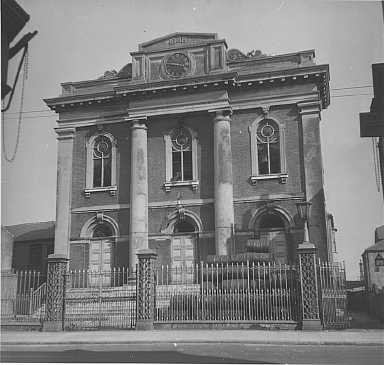Some members of Above Bar Church were more radical than others, and were not happy with the views held by most Above Bar members. In 1844 the brothers William and Joseph Lankester were the instigators of the schism that led forty six members of Above Bar Church to break away, and form their own, more radical congregation. At first they worshipped in temporary buildings, but soon bought the old infirmary in St Mary Street, and converted it into The Albion Chapel, which opened on September 15th 1844. The infirmary had become vacant with the opening of the new Royal South Hants hospital, and was bought by Joseph Lankester for £900. Fitting up the old infirmary for worship cost a further £780, and an adjacent piece of land cost them another £350. This was a lot of money for a small congregation to find. There was an appeal, and we know that Thomas Adkins of Above Bar gave £25. Having formed a congregation they looked for a pastor and appointed Rev Thomas Pullar of Gateshead on 7.9.1845. The church minutes for the new Albion church say that” it was resolved that for the present Dr Watts’ Psalms and hymns be exclusively used for public worship”. The congregation later decided to build their own church building on land behind the old infirmary. During building work services were held alternatively at Portland Chapel and in large store rooms in Paget Street. The cost of the old infirmary building had been paid off by October 1847. The new chapel building, in the classical ionic style, cost £5223 4s. 3d, and was 50 foot by 80 foot with a double gallery, and could seat 1200 worshippers. It had a lecture room that sat 250 and separate classrooms for 400 young men and women which were 12.5 foot high, as well as an infant’s classroom for 150 children. There was a committee room over the minister’s vestry called the Dorcas Room. This new building was opened on Wednesday 13th June 1849. The architect was W. Hinves, the builder Thomas Atkinson Gates and the plasterwork was done by Charles Scorey. According to The Hampshire Independent of 16.6.1849 “The internal appearance is chaste and beautiful. The pulpit is of unique construction of moulded front and sides, approaches by double stairs. The pews are constructed with sloping backs and flush panels and doors ramped below the backs, which combines to give them a peculiarly light and airy character. Every pew has a fixed book board, and convenience to hats and umbrellas”
The site was significant as the St Mary’s area of the city was growing fast, along with a growth in nonconformism. Soon after forming Albion Church, William Lankester and other extremists joined with the more extreme Baptists in the city to hold a meeting in The Long Rooms to hear a London minister speak on “The connection between the church and the state”. They formed the Southampton Nonconformist Association. Rev T Pullar, Albion’s minister from 1845, was a prominent member. At this time the issue of nonconformists paying church rates was an unacceptable fact. Some Anglicans churches held a truce, but others attempted unsuccessfully to charge nonconformists. Eventually in 1868 compulsory church rates were abolished by law, although even in 2013 the act is still on the statute books. Nonconformity in religion and radicalism in politics were closely linked. After the Test and Corporation Act had been repealed in 1828 nonconformists could be on the town council. This didn’t happen easily, as the council chose its own recruits, but Joseph Lankester from Above Bar (and later Albion) did join the council. The middle of the nineteenth century was a period of great expansion of nonconformism. Between 1851 and 1881 accommodation in churches in the borough of Southampton had increased by 4781, but the established church had provided only 124 of these. By the end of the nineteenth century some of the wealthier people in the town had moved out to the leafy northern suburbs of the town. Those worshipping at Albion moved, and in 1892 formed their own church in the Avenue, calling it Avenue Congregational Church. An even earlier breakaway had occurred in 1853 when Rev Joseph Wyld, who was not acceptable to some of the congregation of Albion, or them to him, left to form the Kingsfield Congregational Church. In 1900 unspecified building work was again needed at Albion, and the church hired The Victoria Rooms, on Portland Terrace, in the town, and put on a 3 day presentation on “Our Indian Empire”, which raised over £1000 for the church, which helped towards the £2000 needed. The membership of Albion dropped in the 20th century. In 1901 it had 525 members, but by 1914 this had become 466. However, as the town prospered, fewer and fewer people lived in the St Mary’s area of the city, and in October 1935 Albion Church congregation decided to close their church and join other fellowships in the town. Many of them joined Avenue Church which had been their newly formed daughter church just over 40 years previously. The Church building was demolished in the 1970s
Ministers of Albion Chapel
1845-1850 Thomas Pullar
1851-1853 Joseph W Wyld
1854-1862 William Roberts
1862-1877 Septimus March
1878-1879Samuel Barnes Driver
1881-1888 Stephen George Matthews B.A.
1889-1894 Arthur Seys Howell
1895-1903 Henry John Perkins
1904-1917 Ieuan Maldwyn Jones
1918-1921 William Wood
1925-1928 Ernest G. Mitchell

